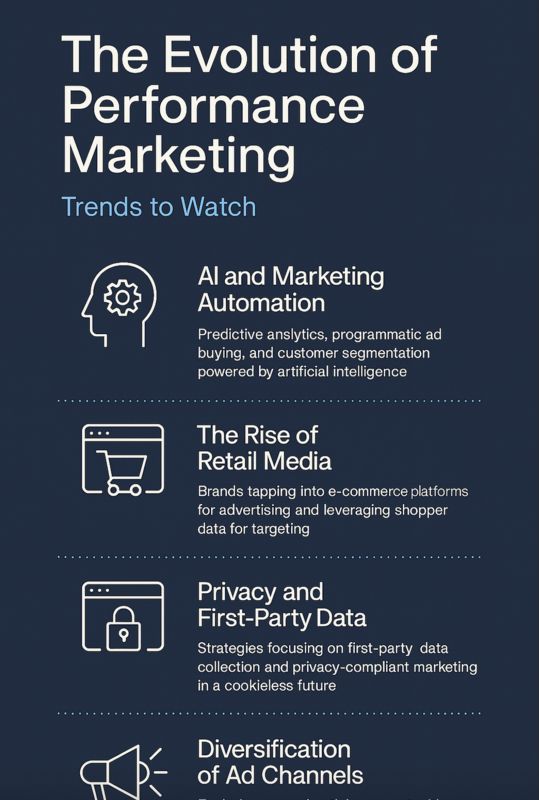In the dynamic world of digital advertising, performance marketing has emerged as one of the most measurable, accountable, and result-oriented approaches to customer acquisition. Unlike traditional branding campaigns, performance marketing is all about outcomes: clicks, leads, conversions, and revenue. But as platforms, consumer behaviors, and technologies evolve, so too does performance marketing. To stay competitive, marketers must understand where the field is heading and what innovations are reshaping its future.
From Clicks to Conversions: A Brief Look Back

Performance marketing began with a simple premise: advertisers should only pay for measurable results. In its early days, this meant basic pay-per-click (PPC) models, affiliate partnerships, and email marketing campaigns with trackable links. Marketers relied heavily on Google Ads and early social platforms to generate traffic and measure conversions via cookies and last-click attribution.
While these foundational tactics remain important, the landscape has become significantly more complex. Today’s performance marketers must navigate a multi-device, multi-channel ecosystem that demands far more precision, creativity, and real-time data intelligence.
Trend 1: The Rise of AI and Automation

Artificial intelligence (AI) has quickly become a central force in performance marketing. Platforms like Google Ads and Meta are increasingly driven by machine learning, automatically optimizing campaigns based on historical data, user behavior, and predicted outcomes.
Marketers are now leveraging AI for audience segmentation, dynamic ad creation, bidding strategies, and even copy generation. Automation reduces the need for manual adjustments, allowing marketers to focus on strategic oversight rather than day-to-day management.
Why it matters: AI enhances efficiency and scale, helping campaigns adapt in real time to deliver better results with less guesswork.
Trend 2: First-Party Data Takes the Lead
With the phasing out of third-party cookies and growing concerns around user privacy, marketers are turning their attention to first-party data. Collected directly from customers through websites, apps, or CRM systems, first-party data offers a more accurate and privacy-compliant foundation for targeting.
Brands are investing in tools that consolidate and activate their first-party data, such as customer data platforms (CDPs), to build richer customer profiles and power personalized experiences.
Why it matters: First-party data not only improves targeting accuracy but also ensures compliance with evolving privacy laws such as GDPR and CCPA.
Trend 3: Cross-Channel and Omnichannel Strategies
Today’s consumers switch between devices and platforms throughout their buying journey. Successful performance marketing campaigns must follow this path, integrating channels like search, social, email, display, video, and even SMS into a cohesive user experience.
An omnichannel strategy ensures that each touchpoint reinforces the brand message and nudges users closer to conversion—no matter where they interact.
Why it matters: Cross-channel synergy maximizes campaign impact and improves customer lifetime value by maintaining continuity across the journey.
Trend 4: Measurement Goes Beyond Last-Click Attribution
Traditional last-click attribution gives all the credit for a conversion to the final touchpoint, but it fails to reflect the complexity of modern customer journeys. Marketers are adopting more sophisticated attribution models—such as linear, time decay, and data-driven attribution—to better understand how each interaction contributes to the final result.
Why it matters: Improved attribution helps allocate budget more effectively and identify high-performing content and channels that might be undervalued by simplistic models.
Trend 5: Creative Optimization with Data
In performance marketing, content is still king—but data now wears the crown. Marketers are increasingly using data to inform creative decisions, from headline variations to visual design and call-to-action placement.
Multivariate testing and dynamic creative optimization (DCO) allow brands to test multiple versions of an ad simultaneously and serve the best-performing combinations based on real-time engagement data.
Why it matters: Data-driven creativity ensures that content resonates with the target audience, boosting engagement and conversion rates.
Trend 6: Performance Marketing Meets Influencer Strategy
The influencer economy has expanded into performance marketing, with brands tracking ROI from influencer partnerships via unique codes, affiliate links, and post-campaign analytics. This allows for a hybrid approach that combines storytelling with direct conversion tracking.
Why it matters: Influencers can drive measurable results while adding credibility and authenticity that traditional ads may lack.
Looking Ahead
As technology and consumer expectations continue to evolve, performance marketing will become even more intelligent, integrated, and personalized. Marketers who invest in data infrastructure, automation, and creative agility will be best positioned to lead in this fast-moving space.
In the end, performance marketing isn’t just about numbers—it’s about insights. And those who can interpret and act on those insights at speed will define the next generation of marketing success.

Hi, this is a comment.
To get started with moderating, editing, and deleting comments, please visit the Comments screen in the dashboard.
Commenter avatars come from Gravatar.